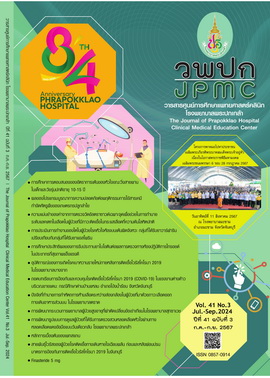A Development of Same Day Discharge Care Model for Patients Undergoing Elective Coronary Angiogram Transradial Catheterization in Prapokklao Hospital
Main Article Content
Abstract
BACKGROUND: The Heart Center at Phrapokklao Hospital has seen an increased number of cardiovascular catheterization service recipients, but has a limited number of inpatient beds. This results in longer waiting times for coronary artery catheterization procedures. Developing patient care models can increase access to appropriate services and encourage nurses to have standard nursing practices.
OBJECTIVES: To develop a model and study the results after using a same-day care model for patients receiving coronary angiogram transradial catheterization.
METHODS: This study used a research and development approach to examine a multidisciplinary heart disease center population at Phrapokklao Hospital, comprising 17 patients and 20 pre-arranged coronary catheterization patients. The procedure consists of studying and analyzing the care situation for patients undergoing same-day coronary artery bypass catheterization at the Heart Center at Phrapokklao Hospital. The researcher developed a new model. Content validity was assessed by experts. The format included patient assessment before, during, and after coronary angiography until discharge within 1 day, follow-up by telephone, and evaluation of subcutaneous hematoma from post-procedure photographs 24 hours later. The model was piloted and evaluated for the results of subcutaneous hematomas after 24 hours of cardiac catheterization, and the number of patients who could be discharged within one day. The waiting times for cardiac catheterization, before and after using the developed model, were compared. Data were analyzed using descriptive statistics, the Mann-Whitney Test and content analysis.
RESULTS: Patients who received care according to this model did not develop hematomas under the skin of the wrist 24 hours after the procedure, accounting for 100%. Patients were successfully discharged within one day, accounting for 95%, and the waiting times for examination were comparable. During the same period in the previous year, the decrease was statistically significant (p<0.01).
CONCLUSIONS: The developed care model can be used as a guideline for patient care to meet increased standards.
Article Details

This work is licensed under a Creative Commons Attribution-NonCommercial-NoDerivatives 4.0 International License.
References
World Health Organization. Health in 2015: from MDGs, millennium development goals to SDGs, sustainable development goals, 2015. Geneva: WHO Press; 2015.
ThaiHealthStat. Death Report [Internet]. 2020 [cited 2024 Apr 14]. Available from: https://www.hiso.or.th/thaihealthstat/system/index.php?t=03
Roy S, Kabach M, Patel DB, Guzman LA, Jovin IS. Radial artery access complications: prevention, diagnosis and management. Cardiovasc Revasc Med 2022;40:163-71.
The Heart Association of Thailand Under the Royal Patronage of H.M. The King. Thai acute coronary syndromes guidelines 2020. Bangkok: The Heart Association of Thailand; 2020.
Writing Committee; Rao SV, Vidovich MI, Gilchrist IC, Gulati R, Gutierrez JA, et al. 2021 ACC expert consensus decision pathway on same-day discharge after percutaneous coronary intervention: a report of the American college of cardiology solution set oversight committee. J Am Coll Cardiol 2021;77:811-25.
Amin AP, Patterson M, House JA, Giersiefen H, Spertus JA, Baklanov DV, et al. Costs associated with access site and same-day discharge among Medicare beneficiaries undergoing percutaneous coronary intervention: an evaluation of the current percutaneous coronary intervention care pathways in the United States. JACC Cardiovasc Interv 2017;10:342-51.
Chen Y, Marshall AP, Lin FF. Outcomes of same day discharge after percutaneous coronary intervention: a quality improvement project. Collegian 2020;28:214-21.
Duangrat T, Ratanachu-ek T, Visanuyothin T, Phanthabordeekorn W, Nimmanwudipong T, editors. Safety in One Day Surgery (ODS). Nonthaburi: Ministry of Public Health; 2018.
McMillan J, Schumacher S. Research in education: evidence-based inquiry. 7th ed. London: Pearson; 2009.
Titano JJ, Biederman DM, Zech J, Korff R, Ranade M, Patel R, et al. Safety and outcomes of transradial access in patients with international normalized ratio 1.5 or above. J Vasc Interv Radiol 2018;29:383-8.
Sriseng A. Transradial catheterization. Siriraj Med Bull 2017;10:90-6.
Supina P, Nawut N. Nursing manual for patients with acute coronary syndrome undergoing percutaneous coronary intervention through transradial approach [Internet]. 2015 [cited 2020 Jan 20]. Available from: https://repository.li.mahidol.ac.th/handle/123456789/17213
Ramharrack DV, Jurgens CY, Shlofmitz RA. Phenotype of same-day-discharge patients after percutaneous coronary intervention. J Cardiovasc Nurs 2018;33:160-7.
Ritklar L, Piyayotai D. Effects of clinical nursing practice guideline for nursing care of patients with coronary artery disease: undergone coronary angiography on complications and anxiety levels in medical unit, Thammasat university hospital. Nursing Journal CMU 2019;46(4):149-57.
Webner C. Discharging a patient after a percutaneous coronary intervention. Crit Care Nurse 2018;38:80-1.
Prateepmanowong J, Chouyboon S, Nareumanphokin N. Nursing care for patients undergoing transradial cardiac catheterization: case study. Thai Journal of Cardio-Thoracic Nursing 2020;30(2):2-14.
Elfandi A, Safirstein JG. Transradial PCI and same day discharge. Curr Treat Options Cardiovasc Med 2018;20:10.

